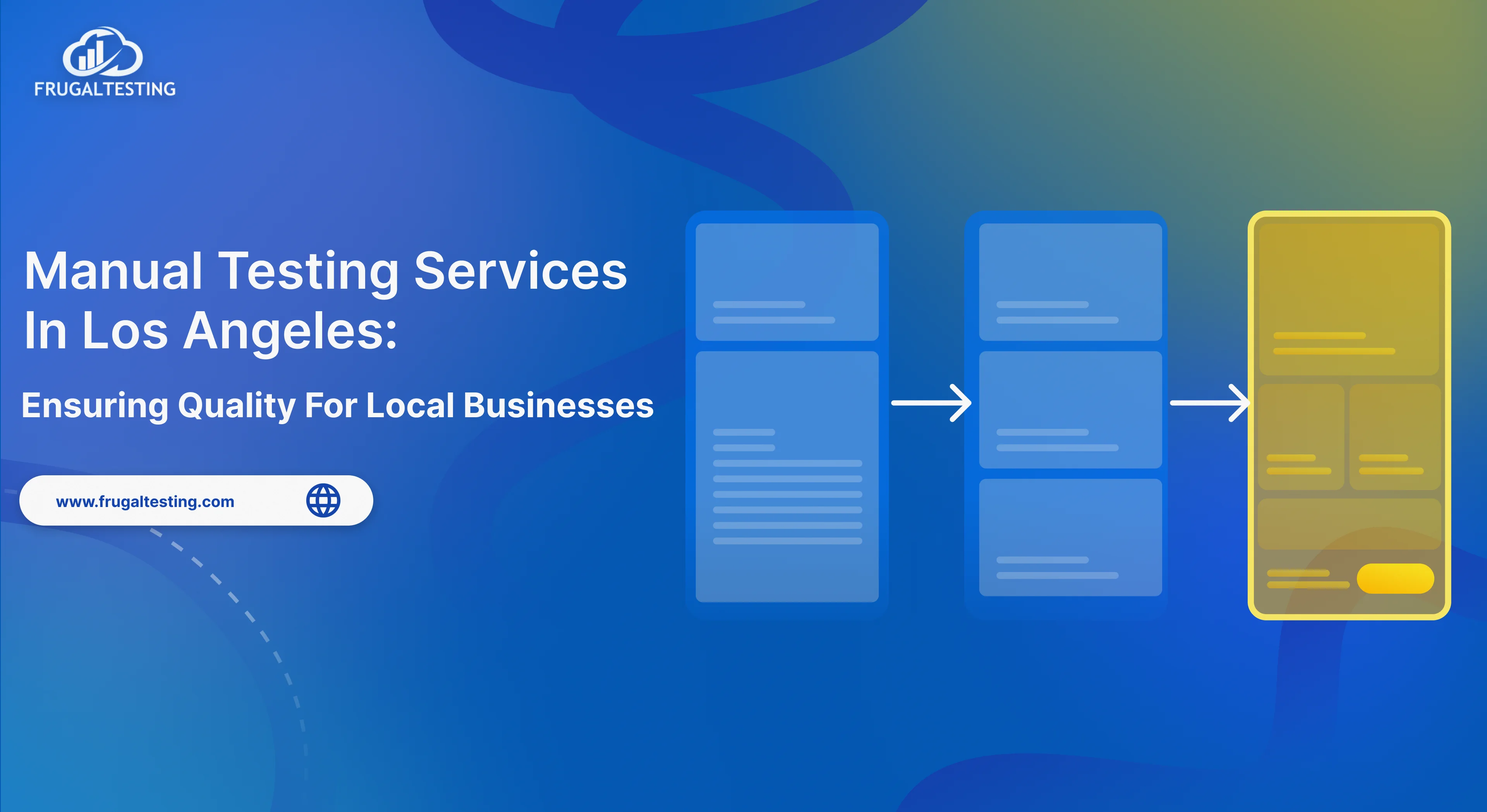Offshore QA outsourcing offers clear benefits for companies looking to scale testing with cost savings and flexibility. However, navigating the unpredictable terrain of remote collaboration is a daunting task that requires a strategic approach centered on agile practices, automation, and strong project management.
Effective communication and building trust are essential to overcoming challenges like time zone gaps and process alignment. For any queries or to explore offshore partnerships, companies can reach out via our dedicated contact us portal, ensuring clear communication throughout the project.
To ensure success, clear guidelines around privacy policy, terms of use, and service location must be established, along with reliable customer service and accessible business email contacts. This structured approach helps companies thrive despite the complex, evolving landscape of offshore QA outsourcing.
💡 Here’s what you’ll learn:
🚀 What offshore QA outsourcing is and how it supports agile and scalable testing?
🚀Common challenges like communication, time zones, security, and ways to overcome them
🚀How to integrate offshore QA teams with CI/CD pipelines and test automation?
🚀Real-world success stories of offshore QA implementations
🚀How frugal testing improves offshore QA efficiency and cost-effectiveness?
What Is Offshore QA Outsourcing?
Offshore QA outsourcing is the process of delegating quality assurance in software testing to external vendors located in other countries, typically where labor costs are lower but technical expertise remains high. Companies often partner with QA outsourcing services or software testing outsourcing companies to scale testing, reduce operational costs, and enhance time-to-market.
These offshore teams provide a wide range of QA testing services, including test automation, CI/CD testing, and penetration testing software, as well as software integration to support secure, high-quality product releases.
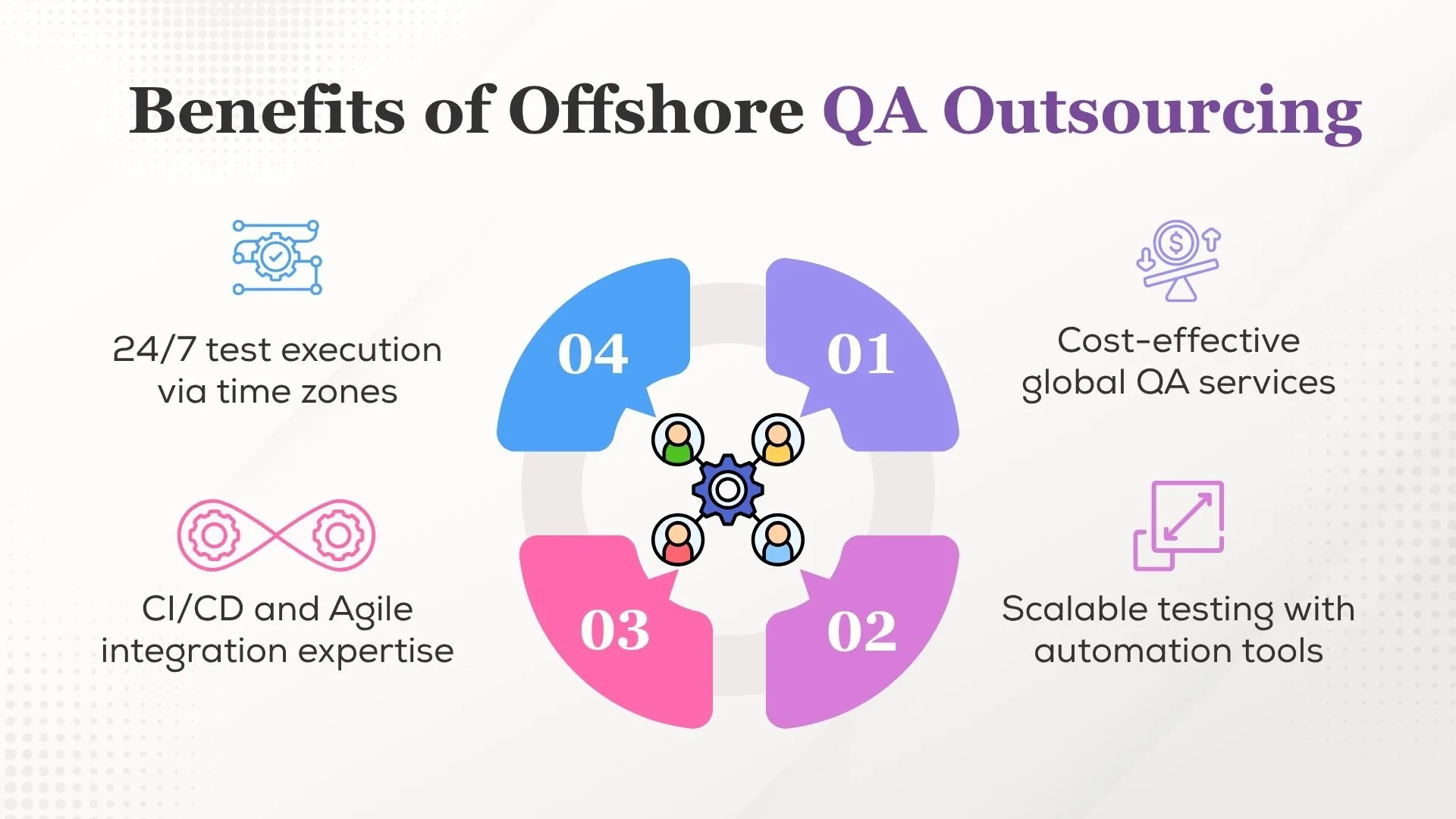
By working with QA outsourcing companies, businesses can access specialized skills in software QA tools, test automation frameworks, and CI/CD pipelines that may not be available in-house. This model is especially beneficial for agile-driven organizations aiming for frequent and reliable software releases.
Partnering with trusted software testing outsourcing companies ensures faster software delivery and optimized QA workflows. Offshore QA outsourcing also strengthens CI CD pipeline efficiency for agile enterprises.
Common Challenges Faced in Offshore QA Outsourcing
Offshore QA outsourcing brings scalability to software development but also introduces challenges that can impact project outcomes, timelines, and overall software quality assurance services. Effective project management and communication channels are critical factors when working with offshore partners across global talent pools.
Challenges such as communication gaps, time zone differences, and inconsistent QA standards require a proactive approach. Building strong relationships and ensuring effective communication with offshore teams is essential to successfully managing remote QA testing tools & services and delivering quality results.
Overcoming Communication Barriers in Distributed QA Teams
Ineffective communication is one of the main obstacles to offshore QA collaboration. In distributed environments, inconsistent updates, language gaps, and asynchronous collaboration can lead to misunderstood requirements or testing errors.
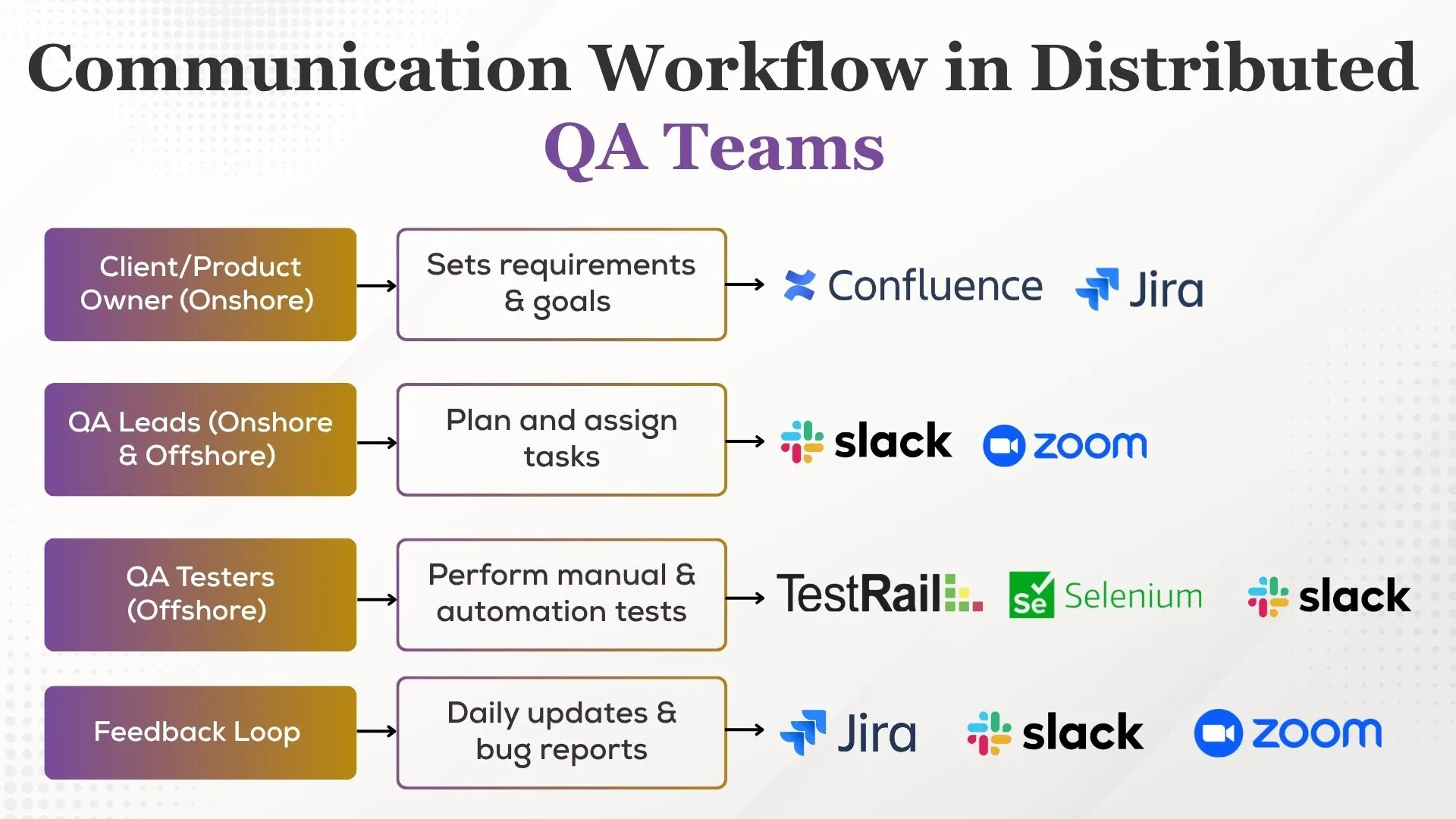
Solutions Implemented in Workflow:
- Real-time collaboration through Slack and Zoom.
- Daily updates and task assignment to prevent misalignment.
- Centralized requirements and documentation using Jira and Confluence.
By streamlining distributed QA communication workflows, offshore teams minimize testing delays and avoid requirement ambiguities. Efficient collaboration tools empower remote QA testers for higher productivity.
Managing Time Zone Differences Without Affecting QA Cycles
Time zone gaps between onshore and offshore QA teams, especially in regions like Eastern Europe, can delay feedback cycles and slow down CI/CD testing and delivery timelines. However, with a strategic approach and leveraging the right skills and expertise from the outsourcing market, these differences can become an operational advantage. Proper planning helps reduce operational expenses while enabling continuous testing and faster releases across global teams.

By effectively managing time zone differences, offshore QA teams enable 24/7 testing cycles, accelerating CI/CD pipelines and improving overall software delivery speed. Leveraging global talent pools ensures seamless collaboration and continuous quality assurance.
Resolving Cultural and Work Ethic Misalignment in Offshore QA
In offshore outsourcing, cultural and work ethic differences can affect team productivity and collaboration. Misaligned expectations, communication styles, and escalation methods may disrupt testing priorities and schedules. Addressing these gaps through cultural training and clear communication protocols is key to successful offshore outsourcing partnerships and smooth QA delivery.
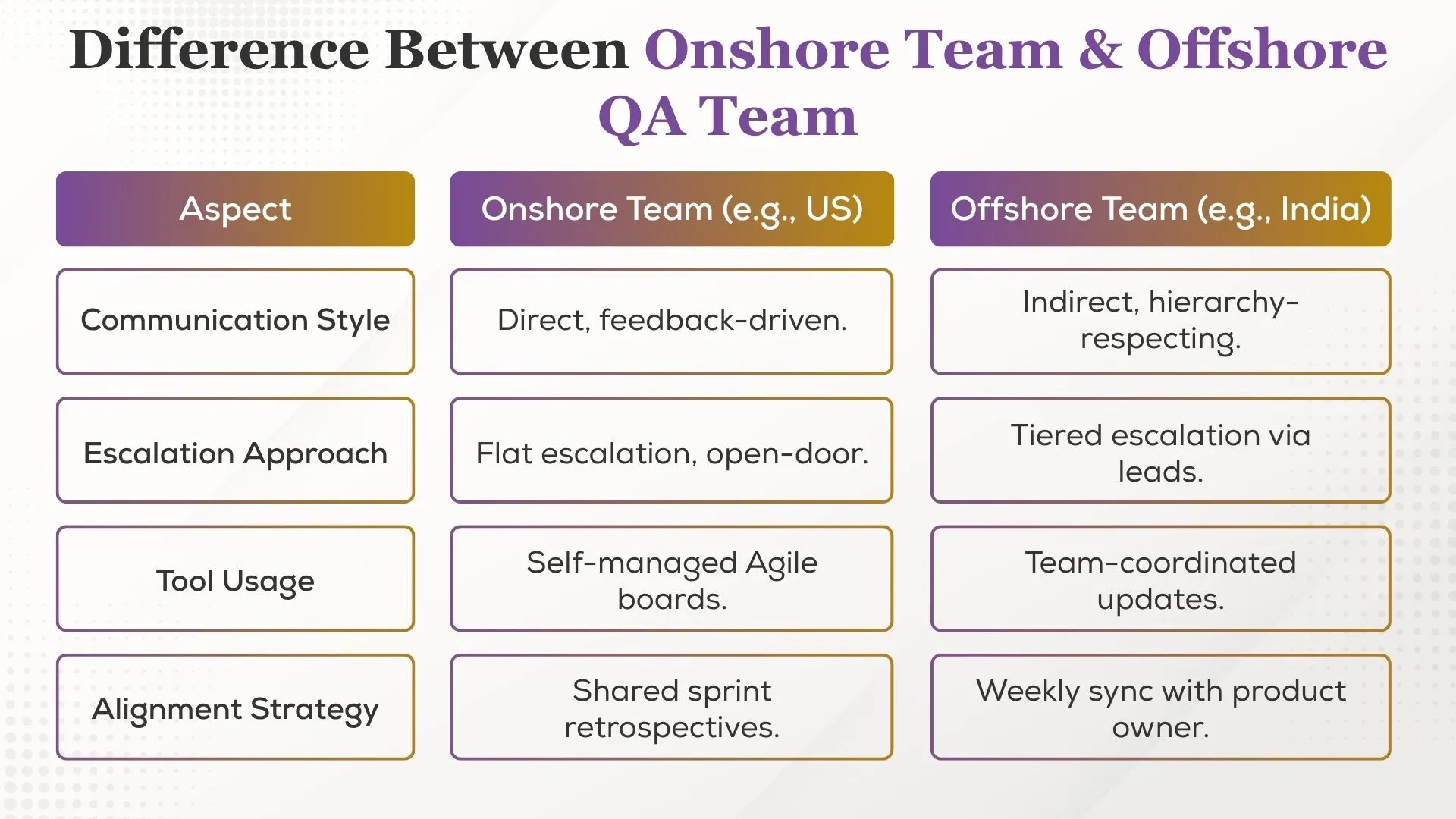
Solutions for Bridging Cultural and Work Ethic Differences:
- Conduct onboarding and cultural training sessions
- Promote transparency through shared sprint retrospectives and sync calls
- Establish clearly defined escalation paths documented in the Privacy Policy and Terms of Use to align with service agreements
Leveraging diverse cultural strengths while aligning work ethics ensures consistent customer service delivery, regardless of service location.
Standardizing QA Processes Across Onshore and Offshore Teams
Without robust quality assurance processes and consistent workflows, testing quality suffers significantly. Diverse tools, inconsistent QA metrics, and unaligned reporting formats create chaos in software testing outsourcing services.
Building trust between onshore and offshore teams requires the establishment of strong communication channels and frequent updates. Aligning logistics systems and adhering to privacy regulations ensures high-quality software delivery while protecting data.
Solutions to Standardize QA:
- Define service-wide SLAs for test execution and defect reporting
- Ensure that onshore and offshore QA teams follow a shared Terms of Use for collaboration
- Set up a centralized reporting mechanism aligned with customer service expectations and compliance norms
- Maintain documentation repositories and regular sync-ups to improve traceability across service locations
Standardizing QA fosters greater transparency, productivity, and long-term consistency across global delivery teams.
Addressing Documentation Gaps in Offshore Testing Projects
In offshore outsourcing, poor documentation is a critical challenge that leads to confusion, rework, and missed defects. Clear and consistent documentation, especially test cases, edge conditions, and requirement traceability, is essential to ensure accurate understanding and smooth QA delivery across distributed teams. Proper documentation practices bridge communication gaps and prevent misinterpretation in outsourced QA environments.
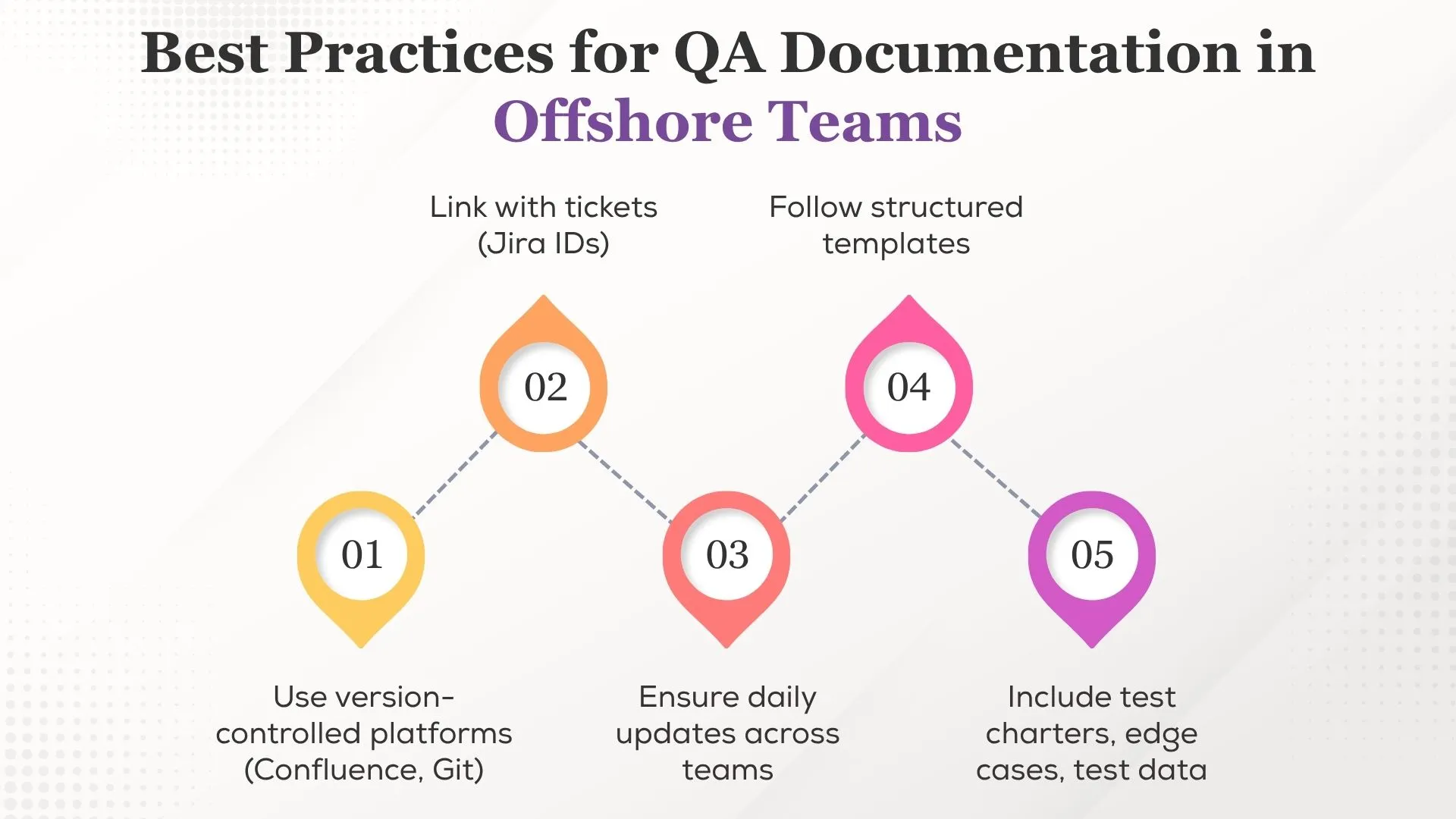
Solutions to Strengthen QA Documentation:
- Automate generation of test summaries and traceability reports using CI/CD tools.
- Enforce regular documentation reviews during sprint retrospectives.
- Maintain centralized repositories aligned with Privacy Policy and Terms of Use across all service locations.
- Integrate documentation workflows with customer service touchpoints for faster issue resolution.
Strong documentation ensures quality alignment between onshore and offshore teams, enabling defect-free, audit-ready, and transparent QA execution.
Bridging Skill Gaps Through Technical Evaluation and Training
Offshore outsourcing can expose skill gaps in areas like test automation, CI/CD, and application security testing. To deliver consistent results, leading offshore outsourcing providers adopt structured training roadmaps and technical assessments. This improves tool proficiency, test accuracy, and adaptability across distributed QA teams.
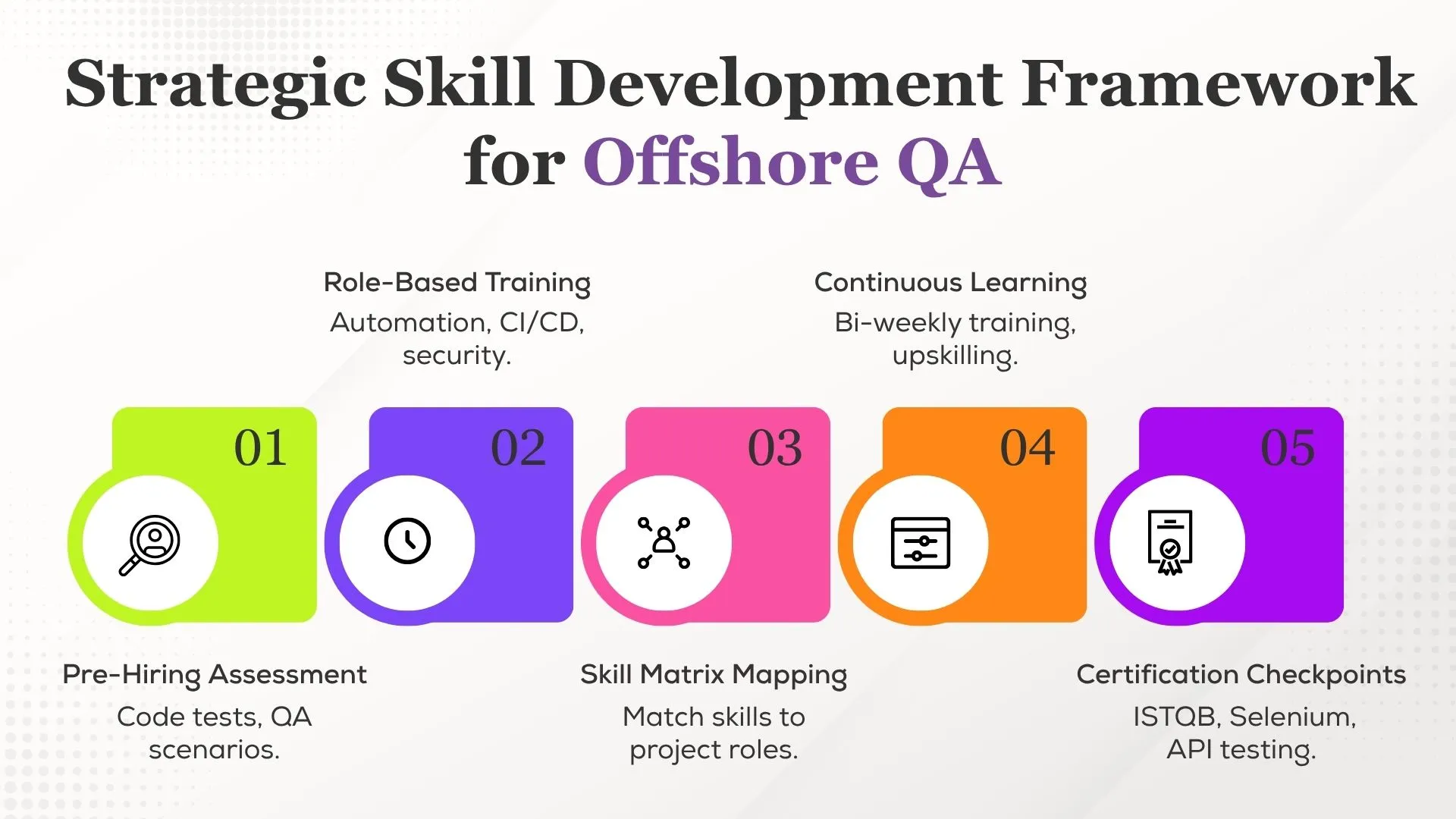
Solutions to Bridge QA Skill Gaps:
- Conduct pre-hiring skill assessments and code challenges.
- Run role-specific workshops on automation tools and agile QA practices.
- Use skill matrices to assign testers based on expertise and project needs.
- Track learning progress aligned with Business Email communication and Service Location training goals.
Strategic upskilling enhances test quality and ensures your offshore QA workforce evolves with modern software testing tools demands.
Choosing the Right Balance Between Manual and Automated Offshore Testing
In offshore outsourcing, balancing manual and automated testing is critical to achieving both speed and quality. Automation guarantees quicker, repeatable execution for regression and CI/CD pipelines, while manual testing is crucial for usability and exploratory situations. A hybrid approach ensures optimal coverage, efficiency, and cost-effectiveness across distributed QA services and QA teams.
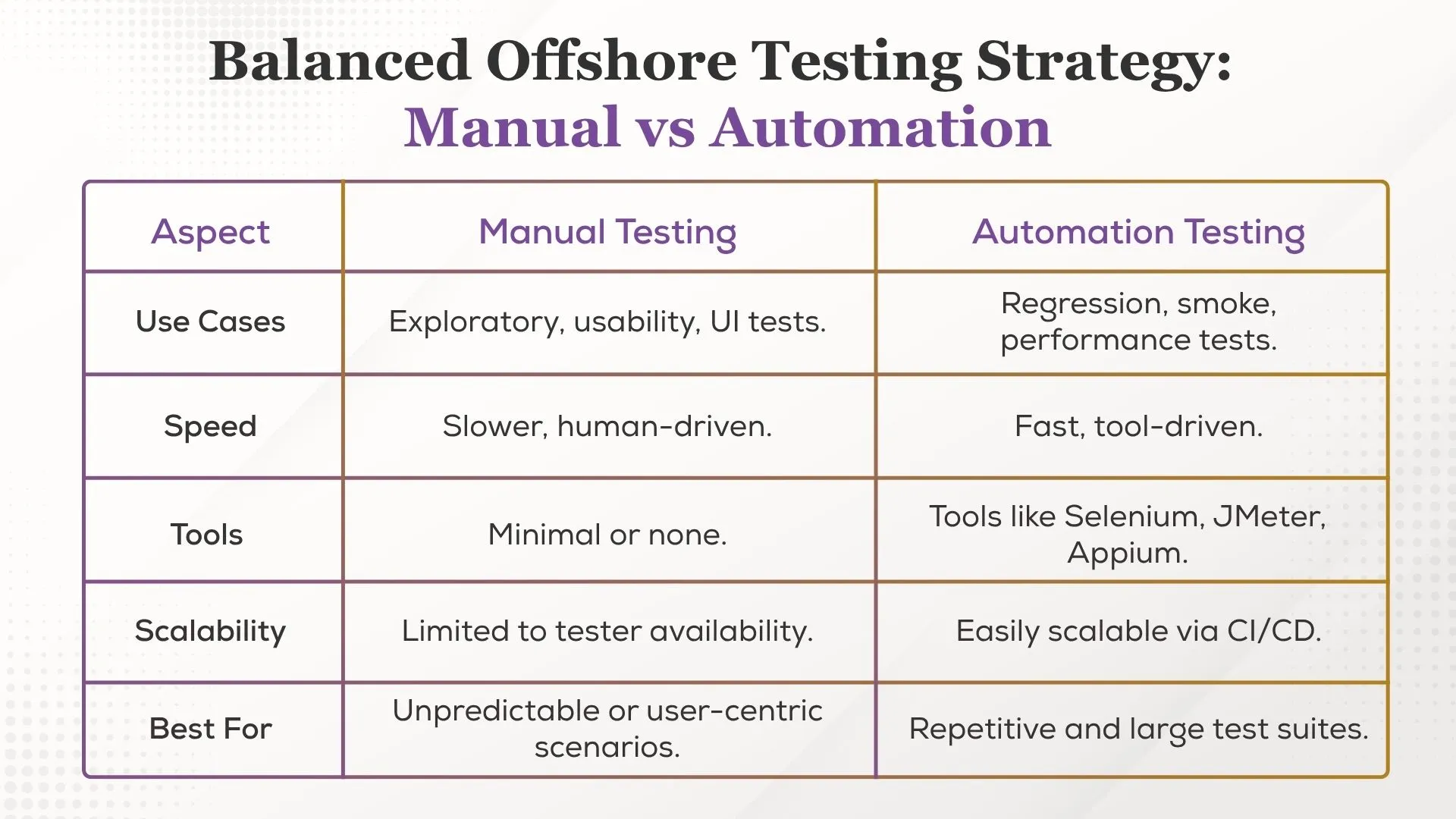
Solutions for Optimal Test Balance:
- Use manual testing for exploratory, usability, and early-stage validation
- Apply test automation services for regression, load, and continuous integration scenarios
- Choose adaptable frameworks (e.g., Selenium, Cypress, JMeter) aligned with Service Location and customer service needs
- Ensure QA teams align testing choices with SLA timelines and product stability
Balanced testing not only accelerates offshore QA cycles but also ensures consistent software delivery across platforms.
Seamlessly Integrating Offshore QA Teams into CI/CD Pipelines
In offshore outsourcing, disconnected QA workflows can stall release velocity. Seamless integration of offshore QA teams into CI/CD pipelines is essential for reducing cycle time and accelerating feedback.
Success depends on strong project governance, reliable communication channels (like business email and customer service portals), and clearly defined service location and responsibilities. Compliance with privacy policy and terms of use further builds trust and ensures regulatory alignment.

Solutions for CI/CD-Ready Offshore QA:
- Embed offshore testers into build-test-deploy cycles
- Use CI/CD tools like Jenkins, GitLab, or Azure DevOps to automate test execution
- Set up real-time QA feedback channels via Slack, Jira, or email
- Monitor results using dashboards for error logs, test coverage, and runtime metrics
A well-integrated offshore QA setup improves visibility, enables faster iterations, and ensures high-quality, compliant releases at scale.
Ensuring Data Security and IP Protection in Offshore QA Projects
In the uncertain world of offshore outsourcing, data security is a major worry and a difficult undertaking. Companies must protect sensitive test data and intellectual property through robust governance and technical controls. This includes clear privacy policy, terms of use, and designated service location disclosures.
Building trust requires transparent project oversight, secure communication through business email, and responsive customer service. Together, these factors form the foundation for a secure, regulation-compliant offshore QA partnership.

Solutions for Offshore QA Security:
- Sign NDAs and enforce RBAC on QA and test automation tools
- Use VPNs, encrypted test environments, and audit logs for traceability
- Choose offshore vendors with ISO 27001 or SOC 2 certifications
- Limit access using role-specific credentials and monitor via centralized logging
These measures ensure that offshore QA teams operate within a secure, accountable, and regulation-ready environment.
Tracking Performance with Offshore QA Metrics and KPIs
Tracking QA performance in offshore outsourcing is essential for maintaining quality standards and ensuring timely deliveries in agile sprints. With clearly defined KPIs, businesses can measure test coverage, defect density, and offshore QA team efficiency enabling proactive decision-making.
Monitoring metrics like test pass rate, automation coverage, and SLA adherence helps companies evaluate the true impact of offshore outsourcing on product stability and release velocity.

Key Metrics to Track:
- Defect density and test coverage trends
- Automation rate vs. manual effort balance
- MTTD and Mean Time to Resolve (MTTR)
- Release cycle velocity influenced by offshore QA team performance
By benchmarking and continuously analyzing these metrics, organizations can maximize the value of offshore QA partnerships and stay aligned with agile delivery goals.
How to Evaluate and Select a Reliable Offshore QA Partner
In the unpredictable terrain of offshore outsourcing, choosing the right QA partner can determine the success or failure of your quality goals. A reliable offshore QA vendor should demonstrate deep expertise in software test automation services, strong alignment with agile framework and CI/CD workflows, and the ability to deliver consistent value.
Evaluating factors like technical proficiency, security compliance, time zone compatibility, and customer service responsiveness is essential. The ideal partner must also provide clear SLAs and proven success in similar projects.
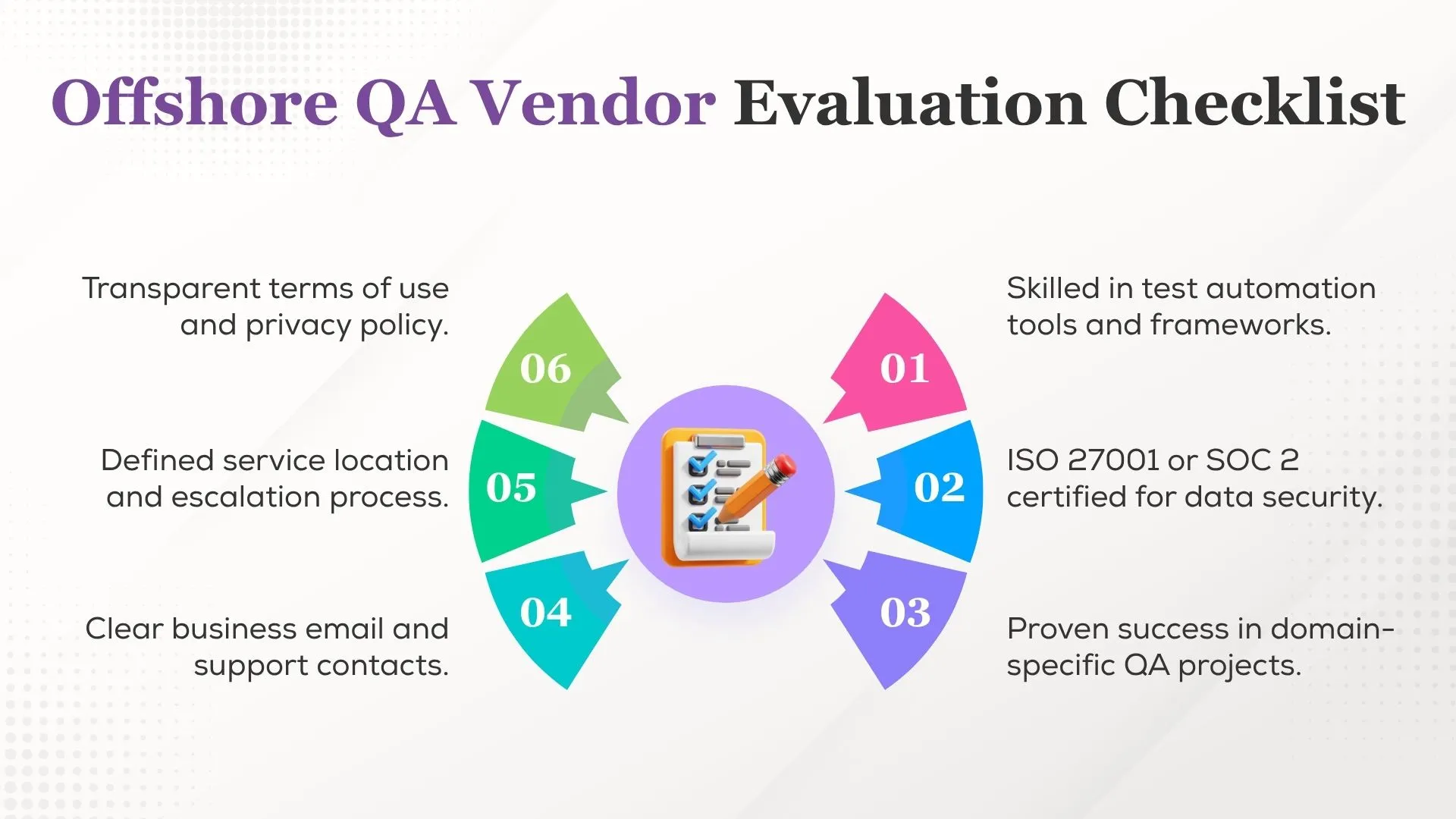
A thorough vetting process ensures your offshore QA partner can scale with your needs, deliver high-impact outcomes, and reduce outsourcing risks.
Key Benefits of Offshore QA for Agile and Scalable Software Testing
Offshore QA supports agile Software Development by offering scalable testing, faster releases, and cost efficiency. It gives access to specialized skills and global talent through offshore partnerships, helping teams adapt quickly.
Despite cultural differences, Language Barriers, and Cultural Norms, strong communication and Building trust ensure smooth collaboration. It also addresses Data Privacy needs, making it ideal for companies looking to scale in the complex terrain of outsourcing.
Key Benefits of Offshore QA Outsourcing:
- On-Demand Scalability: Easily scale QA teams for larger sprints or frequent releases.
- Agile-Ready Teams: Pre-aligned with Scrum or Kanban workflows.
- CI/CD Integration: Seamless plug-in with Jenkins, GitLab CI, CircleCI, etc.
- Test Automation Expertise: High coverage with minimal maintenance.
- 24/7 Testing: Time zone advantage enables continuous execution.
- Tool & Domain Knowledge: Faster onboarding with specialized expertise.
- Cost-Effective Quality: Flexible pricing models without compromising testing depth.
Offshore QA is not just a cost-saving move, it's a pathway to deliver high-quality software at speed, especially when working within CI/CD pipelines or handling complex software test automation services.
Real-World Case Studies of Successful Offshore QA Implementations
Offshore QA outsourcing has proven its value in real-world scenarios where scalability, agility, and rapid delivery are critical. By partnering with experienced QA outsourcing companies, enterprises have achieved significant improvements in software testing services, CI/CD pipeline efficiency, and overall product quality. Below are three standout case studies that illustrate how offshore QA has driven tangible success across industries.
- Case Study 1: Fintech Firm Automates Testing for Faster Releases
- An offshore team automated testing using Selenium and Jenkins, cutting manual effort by 85% and reducing production bugs by 70% within 3 months. CI/CD integration sped up deployments.
- Case Study 2: E-Commerce Platform Achieves 24/7 QA Coverage
- Offshore testers enabled continuous testing across browsers and devices, leveraging time zones for 24/7 coverage. Bug turnaround improved by 50% during peak sales with unified real-time reporting.
- Case Study 3: SaaS Provider Strengthens Security with Offshore Pen Testing
- Offshore experts ran penetration tests and automated vulnerability scans integrated into CI/CD pipelines, identifying 20+ critical issues, achieving GDPR and SOC 2 compliance, and cutting remediation time by 60%.
How Frugal Testing Solves Offshore QA Challenges with Scalable Solutions
Frugal testing uses smart resource allocation, automation, and high-impact test prioritization to deliver cost-effective, scalable QA. It’s ideal for offshore QA outsourcing, helping teams reduce manual effort, streamline processes, and enable faster, reliable CI CD testing without compromising quality.
It helps companies access a larger talent pool, align with agile software development and project management, and address language barriers, cultural norms, and data privacy. Promoting effective communication strengthens third-party teams, builds offshore partnerships, and helps establish trust and transparency.
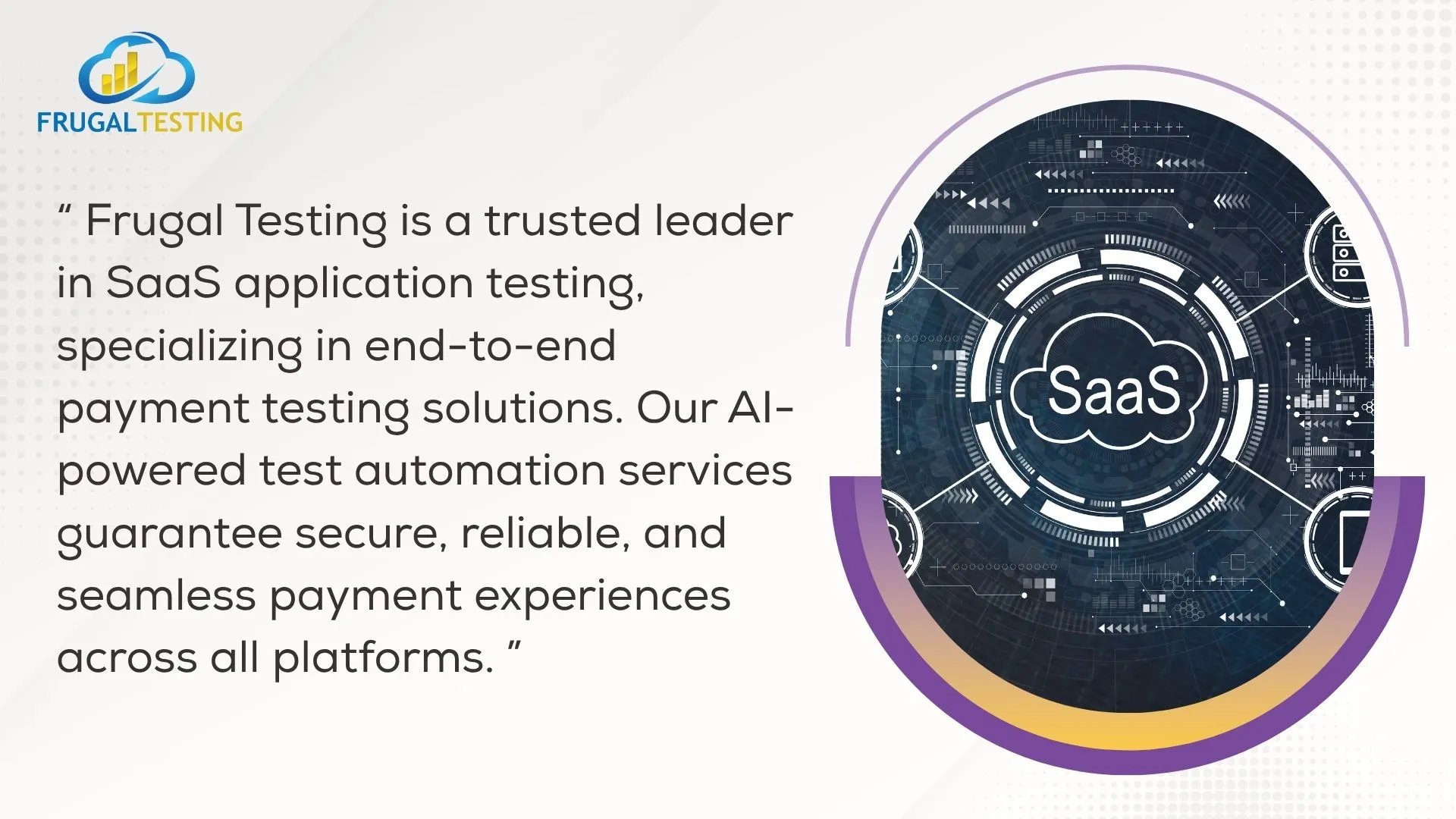
Frugal testing helps companies navigate the unpredictable terrain of offshore outsourcing by focusing on cost-effective automation, agile alignment, and lightweight tools. It prioritizes key tests, uses simple frameworks, and tracks real-time metrics to meet the demands the terrain of outsourcing requires, improving quality and security.
People Also Ask
👉 What are effective governance models for offshore QA teams?
Effective governance models for offshore QA teams combine centralized management with agile collaboration tools, ensuring seamless communication, quality control, and real-time reporting for successful offshore software testing.
👉 What are the legal considerations when outsourcing QA offshore?
Legal considerations in offshore QA outsourcing include strict adherence to data privacy laws, intellectual property protection, confidentiality agreements, and compliance with local labor regulations to mitigate outsourcing risks.
👉 What are the hidden costs in offshore QA outsourcing?
Hidden costs in offshore QA testing outsourcing often arise from communication gaps, time zone challenges, project management overhead, and quality rework, impacting overall software testing ROI.
👉 How can offshore QA teams ensure 24/7 defect triaging and support coverage?
Ensuring 24/7 defect triaging and support coverage in offshore QA teams requires implementing follow-the-sun models, automated defect tracking, and well-defined handoff procedures for continuous software quality assurance.
👉 How to set actionable KPIs for offshore QA success?
Setting actionable KPIs for offshore QA success involves tracking defect detection rates, test coverage metrics, test cycle times, and customer satisfaction scores to optimize offshore QA performance.





%201.webp)
